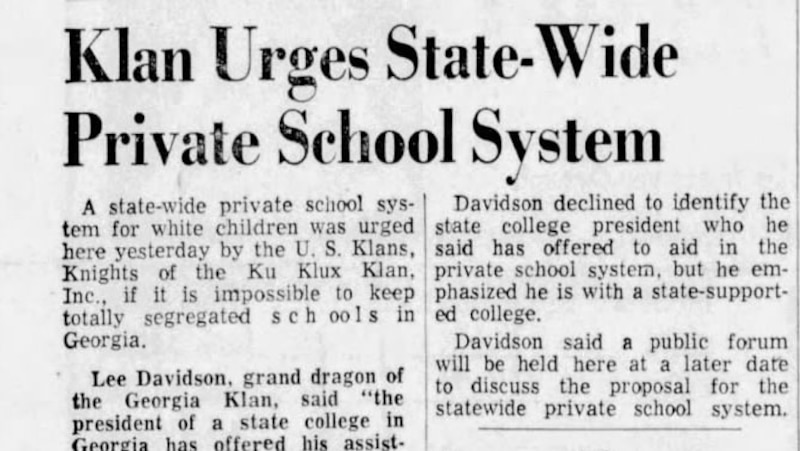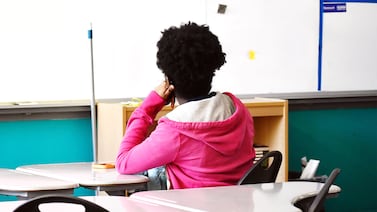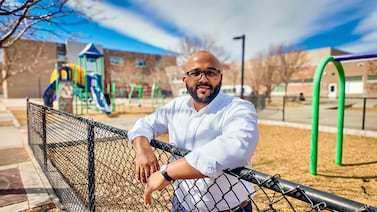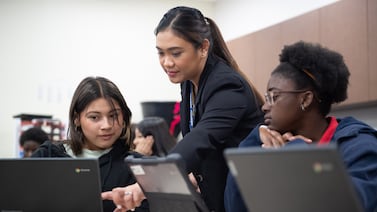This story was originally published by ProPublica and is republished here with permission.
ProPublica is a nonprofit newsroom that investigates abuses of power. Sign up for Dispatches, a newsletter that spotlights wrongdoing around the country, to receive our stories in your inbox every week.
The spry 76-year-old woman finds her spot at the dining room table, prepared to discuss a problem her family has confronted, in one form or another, for half a century. Back when Samaria “Cookie” Mitcham Bailey was a teenager in 1964, she was among the first Black students to desegregate public schools here in Macon, Georgia. She endured the snubs and sacrifices with hope that future generations would know an equality that she had not.
All these years later, that equality remains elusive. Cookie’s hope now centers on the child across the table.
Her 13-year-old great-granddaughter, Zo’e Johnson, doesn’t say much at first. Last year, when she was in sixth grade, Zo’e struggled at the public middle school, which she felt was “chaotic.” Her family canvassed their options for another school in Macon, most of them still largely segregated by race. They chose First Presbyterian Day School, known for its rigorous academics and Christian worldview. It also has a strong tennis program, a draw for a family of tennis standouts.
But FPD isn’t just any private school. It was among the hundreds that opened during desegregation as white children fled the arrival of Black students. Black students like Cookie.
Researchers call these private schools “segregation academies.” Macon was — and is — especially saturated with them. Using archival research and an analysis of federal data, ProPublica identified five that still operate in the city. They include the three largest private schools in town. For generations, they have siphoned off swaths of white families who invested their more plentiful resources in college-sized tuition, fees, and fundraisers. Today, most of Macon’s public schools are nearly all Black — and, because of the city’s persistent wealth gap, they grapple with concentrations of poverty.
At the dining room table on this March day, Zo’e’s family is torn over whether to keep her at FPD for another school year — whether they can afford it and whether the cost makes sense.
All of the schools founded as segregation academies in Macon, a majority-Black city, remain vastly white. FPD, with 11% Black enrollment as of the 2021-22 school year, has the highest proportion of Black students among them. Tuition at these schools can be insurmountable to many Black families. In Macon, the estimated median income of Black households is about half that of white ones.
Zo’e’s family makes it work largely because FPD helped them apply to get almost half of the roughly $17,000 seventh-grade tuition paid through a state voucher-style program — and because Cookie has been able to pay the difference. That’s about $900 a month.
But she isn’t sure she can keep paying. She recently cut her work hours as a medical laboratory supervisor with hopes of retiring in the next few years. At the table, her tone unusually subdued, she notes she’s had COVID-19 twice. Her memory sometimes falters.
“I’m older,” she says. “I’m getting old.”
Zo’e’s mother, Ashley Alexander, is a single parent who works part time and cannot foot the extra bill. She and Zo’e live with Cookie and her husband, a retiree who once worked as an attorney.
Ashley takes a seat between Zo’e and Cookie. “I feel like you get the better opportunity at the Caucasian school. The education is better,” Ashley says. “It’s just so expensive. We’ve been looking for some alternatives.”
But Zo’e doesn’t want to leave FPD. She likes the Christian emphasis. And she appreciates the structure and the calm, both important to a family that’s deeply protective of her.
When Zo’e was 6, her father was shot and killed a mile away from this house. A mural of his face stretches across a nearby building, where she sometimes goes to take pictures and to pray. Her father had supported sending his now-adult son, who plays in the NFL, to another private school in town. It’s one reason Zo’e thinks he would be proud of her succeeding at FPD.
She also has made good friends — Black and white. She likes the challenging academics, the orderly classes, and, especially, its tennis team. Her old school doesn’t have one.
At the table, Zo’e speaks up: “I love FPD.”
***
Once sleepy, depressed even, downtown Macon is enjoying a rebirth in this city that is home to almost 157,000 people. Mercer University, Cookie’s alma mater, brings collegiate vibrance. Several grand churches, Catholic schools, and a hospital add to the bustle, along with the gleaming Tubman African American Museum. In a first-floor exhibit, Cookie’s high school graduation photograph hangs on a long wall that pays tribute to students’ work desegregating Macon’s public schools.
Just beyond the downtown streets lined with coffee shops and restaurants, and the circles of poverty that surround them, Cookie’s brick home sits in a mostly white middle-class neighborhood. She has lived in this house for three decades, trodding its handsome wood floors and adorning it with family photographs.
A few weeks before the dining table discussion, she arrives home wearing a green tracksuit from Florida A&M University, where one of her three daughters played tennis. Cookie just left a tennis tournament. In a tight match, Zo’e beat a fellow FPD player who had bested her several times before. The other player smacked her racket on the court, then kicked it. Cookie was thrilled. She and her husband met playing tennis, and they have multiple collegiate tennis players in their family.
Ashley and Zo’e walk in later with diminished enthusiasm. Zo’e lost her final match, and she’s exhausted and grumpy. She heads to her bedroom where a brown teddy bear awaits along with a poster labeled “Vision Board.” She decorated it with words like “Forgive” and “College” and “God Only.”
“She did good!” Cookie calls down the hall.
Zo’e first dabbled in tennis when she was 6, around the time of her father’s murder. On the court, she could live in the moment, thinking only of the match at hand. It provided relief and focus, especially when anxiety crept in.
She keeps with her a newspaper clipping about her father’s death at 39. To some who read news coverage of his killing, he was a gang leader who spent time in prison. But she and many in the community knew the man who wanted his children and others in the neighborhood to dodge the traps of life — traps she’d begun to encounter at the public middle school.
After Zo’e enrolled at FPD, Ashley began driving her each morning in the opposite direction of the public middle school, which sits a mile away past a strip mall anchored by a Family Dollar.
Instead, they cruised for 15 minutes toward the leafy neighborhoods to the city’s north. At a stretch of white ranch fencing, they turned and drove over gentle hills and then veered onto the main drive into FPD’s campus. Red flags emblazoned with its crest hang on street lamps that line the road as it passes brick buildings, an athletic center, expansive ball fields and a tennis complex along its 248-acre campus.
Zo’e isn’t the first in her family to attend private school. Her older half-brother on her father’s side who plays football went to Stratford, a similarly elite school in town that also was founded as a segregation academy. And a cousin who coaches her in tennis and is now playing on a scholarship at Tuskegee University went to FPD his junior and senior years. He had a mostly good experience, a big reason Cookie took a chance on the school.
Even so, Zo’e felt strange arriving on campus. At her old school, almost 90% of her classmates were Black. Classes were in one building, all near one another. FPD looked like a small college bustling with white students. She worried about what they would think of her.
Yet, she felt welcomed. Most of the kids seemed nice. And they weren’t all white. About 1 in 10 was Black.
She didn’t know it, but after George Floyd was killed in 2020, the head of school had issued a letter warning: “I will not allow racism or a lack of respect of any kind towards anyone.”
As Zo’e settled in with a diverse new group of friends, academics proved her toughest adjustment. So she focused on learning study skills and discipline — and set out to prove herself on the tennis court, which only made Cookie prouder.
Zo’e has lived with Cookie most of her life. She calls her great-grandmother sweet nicknames like Precious. “You are the cookie to my monster!” Zo’e wrote in Cookie’s birthday card.
Much as she respects Cookie, the history of school segregation wasn’t at the forefront of her daily concerns as she assimilated at FPD. But she did notice that she hadn’t seen a single Black teacher at the school. The only Black staff members she saw worked as janitors or in the cafeteria.
***
Cookie’s own journey into the world of white education began in 1964 with an announcement over the loudspeaker at her all-Black high school. The voice sought volunteers to transfer to a school for white girls. Cookie raised her hand.
Her mother, Annie Mae Mitcham, had grown up in a rural outpost called Cat Ridge. As a child in the 1930s and 1940s, Annie Mae walked from her segregated all-Black school with its hand-me-down books to go clean the white kids’ classrooms. She and her husband, who had a third-grade education, raised their 10 children to focus on school achievement.
By volunteering to enroll at the white school, Cookie wanted to see if she was as smart as everyone said she was. She also wanted to know what advantages the white kids were getting — and that Black students ought to have, too. She enrolled her senior year.
When she arrived at the white high school, Cookie didn’t suffer the violence that many Black children who desegregated schools across the South did. But there was one day in English class that still, 60 years later, hurts.
A white girl turned to ask: “Do you have a tail?”
At her old high school, Cookie was an A student. She’d been in the marching band and the concert band. She’d played piano and was a stellar singer. Yet this white girl was comparing her to a monkey? It cut deeply enough to scar.
Something similar happened to Zo’e a semester into her own experience at a mostly white school. She came home from school one day upset. She told Cookie and her mother that she had found a friend, who is Black, crying in a hallway saying that a white boy had just called her a “monkey.”
A month later at the dining room table, the family revisits the monkey comment. Zo’e says she has since heard the boy who said it was suspended. Her mother points out that one student’s comment doesn’t define a school.
“Let’s not make too big an issue of it,” Ashley says. But for Cookie, it rips open the old wound from English class. She grows furious. “They’re still calling Black folks monkeys!”
At the white high school, Cookie’s teachers and most students had treated her well enough. The headmistress did not. The guidance counselor was the worst, with her pursed lips, pearls, and horn-rimmed glasses. When Cookie told the counselor she wanted to apply at Mercer University, the woman replied with a sneer and an insult.
“Go to your own school,” the woman said. In other words, a college for Black students. Cookie stormed from the office and marched to Mercer with a friend. She enrolled on her own and ultimately graduated, among the first Black students to do so from the private university. Yet, even by then, only a smattering of Black students had been admitted to Macon’s white public schools. White Maconites were battling full integration at every turn, especially in the courts.
More quietly, they were also busy forging another kind of resistance: They were organizing new private schools for their white children.
***
Macon sits 90 miles south of Atlanta in Georgia’s stretch of the Black Belt, a sickle-shaped swath of rich soil across the Southeast that once fueled cotton plantation riches. To preserve their control after emancipation, Georgia’s white leaders segregated every facet of life, including the classroom. In 1954, the U.S. Supreme Court upended that when the justices ruled in Brown v. Board of Education that state-mandated public school segregation is unconstitutional.
White residents responded with staunch resistance.
“Klan Urges State-Wide Private School System,” a Macon Telegraph headline announced in January 1960. Two months later, the newspaper reported that a local attorney was leading the charge to create an alternative to the county school system that served Macon. He planned a closed-door meeting with dozens of “persons interested in establishing a private school in case the public schools of Bibb County are closed by the desegregation crisis.”
That fall, Stratford Academy opened. Its leaders chose the name “because of the association of the name with Robert E. Lee and Shakespeare,” officials said at the time. The school — still among the city’s largest and most prestigious academies — was “besieged with applications.”
As white residents fought integration, Sylvia McGee was growing up in the segregated city. She had started her education at an all-Black public elementary school in Macon just a few years after the Brown ruling. She was about to start middle school in 1963 when Black parents sued the local school board in what became Bibb County’s key desegregation lawsuit. The case slogged on for almost seven years.
Finally, in February 1970, an appeals court forced local schools to desegregate — within days. McGee was a high school senior. Whites had fought integration for so long after the Brown decision that she had gone through her entire public school education during that resistance.
That fall, five private schools, including FPD, opened in Macon, doubling the number in town.
Their leaders rarely said publicly that the schools opened to preserve all-white education. Instead, they nodded to “quality” and “Christian” education.
Yet in fall 1970, leaders of the Southern network of the Presbyterian Church urged members to keep their children in public schools. In a statement, they called enforced racial segregation “contrary to the will of God” and warned against undermining public education by establishing and supporting private academies “whose deliberate purpose or practical effect is to maintain racial isolation.”
And even back then, some Southern newspapers called the new private schools “segregation academies.”

“Only the very gullible could deny that race was a factor,” Andrew Manis, a local resident and history professor, wrote in his book “Macon Black and White.”
But FPD’s current spokesperson denied the school was founded as a segregation academy. She told ProPublica it “was established based on the desire of Macon families to provide their children with a strong education, grounded in biblical principles.” The school has a tuition assistance program and a nondiscrimination policy, she added. She did not answer additional questions.
Indeed, in 1975, several years after it opened, FPD’s headmaster likewise told a newspaper reporter that the school had a nondiscrimination policy. FPD was willing to admit a Black student, he said, “but we’ve never had one to apply.”
To Black residents like McGee, that felt disingenuous. “The climate and the culture of the time said you don’t apply to FPD,” she said. Black parents would have feared for their children’s safety at the academies. Private schools also had to adopt such policies or risk losing their tax-exempt status.
McGee graduated in 1970 with the final class before full desegregation. Because so many white students had fled to private schools, by fall 1973, the Bibb County public school system was predominantly Black for the first time.
McGee, who became a social worker and ultimately acting superintendent until 2011, watched the district’s infrastructure crumble. Gone were many of the white parents who had money to pour into PTA fundraisers and time to fill volunteer needs.
In the early 2000s, decades after they opened, FPD, Stratford, and most of the other academies in Macon reported that about 1% to 2% of their students were Black each year.
Even in recent years, Black children have made up only about 6% of most academies’ students — in a county that is 57% Black.
“It holds everybody back,” McGee said. “I think people miss that point.”
***
One morning in May, with the end of seventh grade approaching, Zo’e arrives on FPD’s campus and heads to a hallway of art classrooms. It stretches quiet, the walls lined with impressive student artwork, classes not yet starting for the day. Several students sit on the hall floor, backs against the wall, engrossed in the papers or cellphones in front of them.
For weeks, Zo’e had been living in a tortuous state of uncertainty about whether she would return to FPD in the fall. She tried hard not to complain. She didn’t want to put extra financial pressure on Cookie, who is about to turn 77, or her mom, who has enough on her plate.
Ashley was doing her best to try to make things work for Zo’e. She was in the running for a full-time job at the Bibb County Sheriff’s Office that would give them more of a financial cushion — and enable her to pay FPD’s tuition.
Now, this morning, Zo’e is about to burst with joy. She spots a friend in the hallway and hurries over, stifling her smile. When they get close enough, she whispers, “You know how I told you if my mom doesn’t get the job, I’m not going to be able to stay?”
Her friend looks pensive. Zo’e wrings her hands in front of her.
“She got the job!”
Her friend lets out a high-pitched squeal of joy, then glances down the hall.
Zo’e adds, “So I’m gonna be able to stay.”
But as the next few weeks pass, her hope fades. Delays creep in. Ashley’s starting date gets pushed back.
***
The multiple generations of women in Cookie’s family are quick to debate the bigger reasons why public schools struggle, including Miller Fine Arts Magnet Middle School, the one Zo’e went to.
“There’s a reason why the teachers at Miller are stressed out,” Cookie’s youngest daughter, Alyse Bailey, said after joining her family at the dining room table back in March. “There’s a reason why the kids are not acting how they’re supposed to act. What are those reasons? What are the root causes?”
“They’re a product of the environment,” Ashley responded.
“Right, but then, why?” Alyse asked. “It’s like you got to constantly be asking, why?”
Black children lack resources, Alyse argued, because of the wealth gap stemming from slavery and Jim Crow. “The more you go back, the more you see where it is rooted in systemic injustice.”
To many local families, Miller is the best option among public middle schools. While it functions as a regular neighborhood school, Miller also draws students from across the district who attend its fine arts magnet component. It often tops the district’s six middle schools on the state’s standardized tests. Almost three-quarters of its eighth graders read on grade level or above compared with the district average of 62%. (Private schools don’t have to release such data.)
Schools like Miller will soon find it even harder to retain top students, particularly those with more resources.
Starting next year, private schools will skim another layer of students from the public schools. In April, as part of a nationwide Republican push, Georgia adopted a new program that, similar to the existing one, uses taxpayer dollars to fund private school tuition. At least 21,000 more students could receive up to $6,500 each. Last year, almost 22,000 students tapped into the current program. The average tuition grant was about $4,600.
Supporters often tout these programs as means for students to escape low-performing public schools. But the reality is, the tuition grants don’t often cover even half of private school tuition bills, especially for college prep-style schools like FPD.
Families like Cookie’s must come up with the difference — and, if they can, decide if the financial hardship is worth it.
As they wrestle with this question, Zo’e’s family puts her on a waiting list for a charter school that performs well and, like many of the private schools, draws large numbers of white children. But 40 students are ahead of her.
By the time summer break arrives, Zo’e faces reality. Her mom almost certainly won’t start the new job in time to pay looming tuition bills. Zo’e will return to the public school her family felt had fallen short of her needs. And FPD will have one fewer Black student.
In late June, Cookie’s birthday approaches. When her oldest daughter arrives from Florida for a visit, they lay in bed watching tennis together. In dispirited tones, Cookie mentions that she cannot afford Zo’e’s tuition anymore.
But her daughter presses her to think beyond FPD’s benefits to what public school can provide, if Zo’e works hard and stays focused: “It’s nothing she can’t get somewhere else.”
Cookie concedes, “She can get it somewhere else.” Including Miller. She decides that the family must focus on reinforcing the academic and social self-discipline that Zo’e will need to succeed at Miller. They can help train her in tennis.
In the next room, Zo’e watches Disney Channel cartoons in her bedroom while making a poster for her mom, who shares a birthday with Cookie. She glues photographs onto it along with a message of love in sparkly lime green letters. Then she writes her mother a birthday note. “You’re not only a life-giver but you are a hard worker,” she writes. She thanks Ashley for so much love. “You were the one to step in when my father had to step out. You have been my best friend, a laughing buddy and a role model.”
Zo’e works on the floor below her vision board. It includes a cutout of a tiger’s eyes, intent and fixed. They remind her of focus. As she accepts the likelihood of returning to Miller, she becomes determined to take the discipline she learned at FPD with her. She also remembers that, at this time last year, she had wanted to stay at Miller.
A few weeks later, in mid-July, Ashley gets the formal job offer. She will become a sheriff’s deputy with a start date of July 29. She is overjoyed and relieved.
It comes too late to send Zo’e back to FPD. Public schools are about to begin the new year. So, the family firms up their plan for her. Zo’e will return to Miller for eighth grade to give Ashley time to save money for tuition. After that, when Zo’e begins high school, they plan to send her back to private school.
Zo’e will return to Miller for eighth grade to give her mother time to save money for tuition. After that, when Zo’e begins high school, her family plans to send her back to private school.
Mollie Simon contributed research.






